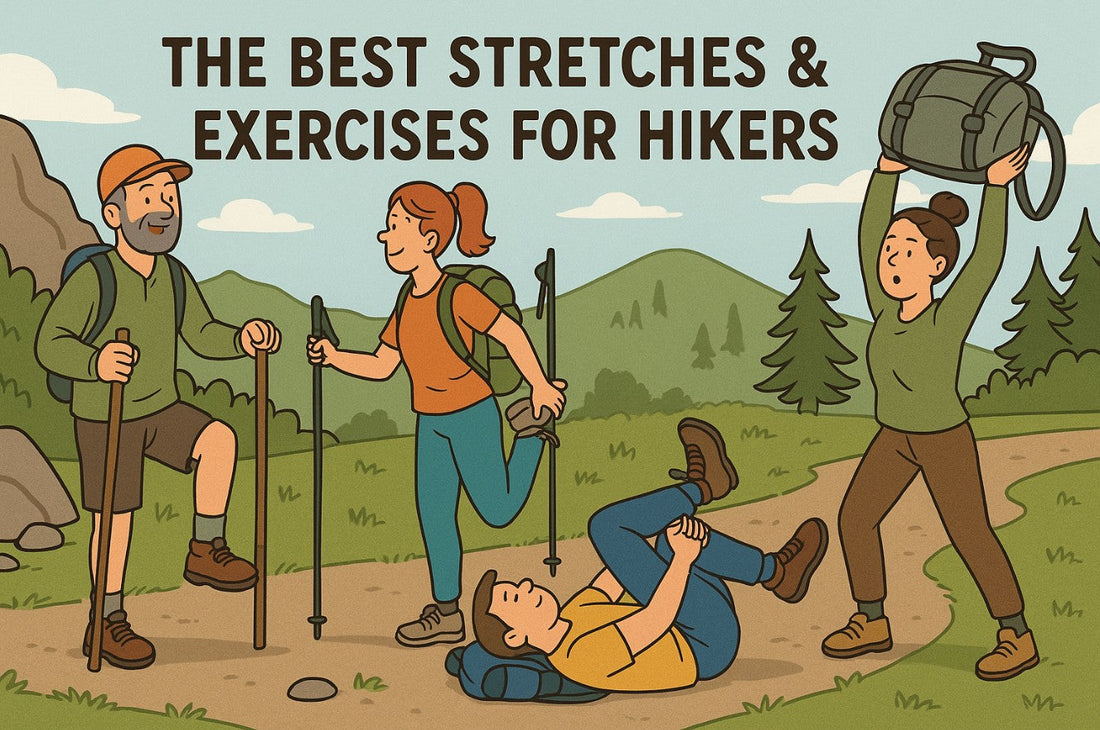
The Best Stretches and Exercises for Hikers
Share
The Best Stretches & Exercises for Hikers
Let’s be honest — most of us are better at planning our snacks than our stretches. But if you’ve ever hobbled around the day after a big hike, or felt your knees yelling at you on a steep descent, you’ll know just how important it is to give your body a little love before and after the trail.
You don’t need a yoga mat or a full workout plan — just a few key moves to keep your hips happy, your calves loose, and your knees functioning like they’re supposed to.
So, in honour of the weekends activities, and my getting caught out busting my knee on a hike because I didn't stretch before setting out — here’s a list of our go-to stretches and exercises that actually make a difference for hikers. They're quick, easy, and trail-tested — and I won't be forgetting to do them again.
Before You Hike: Wake Up Those Muscles
Before you hit the trail, it’s less about deep stretching and more about activation — gently warming up the muscles you’re about to use.
Leg Swings
Hold onto something for balance and swing one leg forward and back, then side to side. 10 swings in each direction per leg. This helps open up the hips and loosen tight hamstrings.
Ankle Rolls
Lift one foot off the ground and roll the ankle slowly in each direction. It’s simple but often skipped — and your ankles are doing a lot of work on uneven trails.
Step-Ups or Glute Bridges (if you have time at home)
Waking up the glutes is key for protecting knees and reducing overuse injuries. Step up onto a bench or do a few glute bridges at home before you leave.
Tip: A short, brisk walk before a longer hike is one of the best warm-ups you can do.
On the Trail: Keep Things Moving
If you’re on a long hike, especially one with big elevation changes, take a moment during your snack breaks to loosen up.
Standing Hip Flexor Stretch
Take a long step back, bend your front knee, and sink into the stretch. You should feel it through the front of your hip. Alternate legs. This helps if your hips get tight from uphill climbing.
Hamstring Stretch
Stand tall, extend one leg out in front of you with the heel on the ground, and gently lean forward. Helps ease lower back and knee tension too.
A quick stretch here and there on the trail can prevent the post-hike soreness from sneaking up on you later.
After the Hike: Recover Right
This is the part we often skip — the car’s in sight, the boots are coming off, and all you want is a cold drink. But spending even 5–10 minutes doing these stretches can make a big difference the next day.
Calf Stretch
Stand with one foot behind the other and lean into a wall or tree. Keep the back heel flat. Helps reduce tightness and supports ankle recovery.
Seated Forward Fold
Sit with your legs outstretched and gently fold forward from the hips. Great for hamstrings and lower back.
Figure Four Stretch
Lie on your back, cross one ankle over the opposite knee, and gently pull the bottom leg toward you. Perfect for glutes and hips — especially after steep climbs or descents.
Quad Stretch
Standing or lying on your side, pull one foot up behind you toward your bum. Keep your knees together and push your hips forward for a proper stretch.
Hold each stretch for 20–30 seconds. Breathe into it. No bouncing.
Exercises to Build Hiking Strength & Mobility
If you’re dealing with recurring soreness or want to prep for harder hikes, these simple exercises are gold:
- Bodyweight Squats – Strengthen quads, glutes, and improve knee support
- Lunges – Build balance and single-leg strength
- Side-Lying Leg Raises or Clamshells – Activate glutes and support hip stability
- Calf Raises – Strengthen lower legs for uphill power and downhill control
- Core Work (planks, bird-dogs, dead bugs) – Support your posture and reduce fatigue
You don’t need a gym. Just 2–3 sessions a week at home can noticeably improve your hiking comfort and performance.
Final Thoughts
You don’t have to do everything. Just pick a few of these to slot into your routine — even one or two stretches after each hike will help your body recover faster and stay injury-free for longer.
Hiking isn’t just about putting one foot in front of the other — it’s about giving those feet (and everything connected to them) the care they deserve.